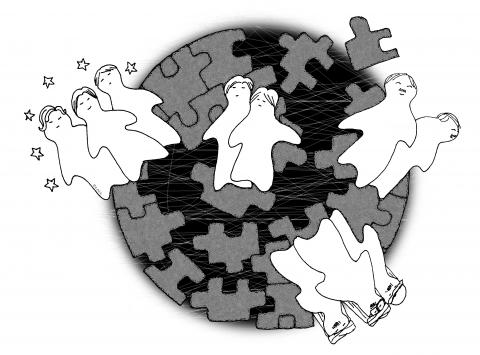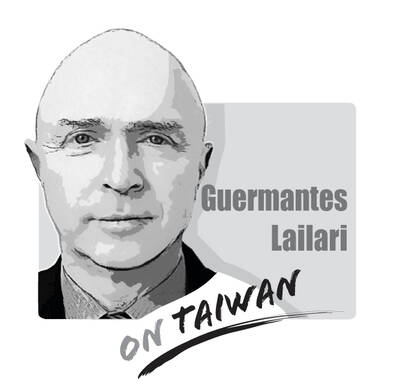At their recent summit in Cannes, the G20 shelved, if not buried, the WTO’s moribund Doha Development Round of multilateral trade negotiations. Crisis-weary Europe and America face a rising tide of protectionism at home and are trying to find ways to blunt the edge of China’s non-transparent trade competitiveness.
Turning his attention from the Atlantic to the Pacific, US President Barack Obama — with his eye, once again, trained on China — has now unveiled a new regional trade initiative. Why was the US unwilling to move forward on the Doha Round, but willing to pursue a regional free-trade agreement?
The answer lies in the fact that the Trans-Pacific Partnership (TPP), launched by Obama and the governments of eight other Pacific economies — Australia, Brunei, Chile, Malaysia, New Zealand, Peru, Singapore and Vietnam — is not just about trade.

While Obama chose to stick to the economic factors driving the TPP, US Secretary of State Hillary Rodham Clinton, on the eve of the just-concluded APEC gathering in Hawaii, laid out the initiative’s wider strategic context.
“The United States will continue to make the case that … [the region] must pursue not just more growth, but better growth,” which “is not merely a matter of economics,” Clinton said.
“Openness, freedom, transparency and fairness have meaning far beyond the business realm,” she continued. “Just as the United States advocates for them in an economic context, we also advocate for them in political and social contexts.”
Following up on these remarks, Obama drew attention to persistent US concern about China’s exchange-rate policy, inadequate protection of intellectual property and impediments to market access.
“For an economy like the United States — where our biggest competitive advantage is our knowledge, our innovation, our patents, our copyrights — for us not to get the kind of protection we need in a large marketplace like China is not acceptable,” Obama said.
The TPP initiative should be viewed against this background and not just in the context of the collapse of the Doha Round.
The TPP’s nine sponsors have resolved “to establish a comprehensive, next-generation regional agreement that liberalizes trade and investment and addresses new and traditional trade issues and 21st century challenges.”
These leaders also agreed to fast-track the TPP initiative and to consider opening it to other members — most importantly Japan, a late convert to the idea of a Pacific region free-trade agreement.
The TPP’s agenda is divided into three categories: core, cross-cutting and emerging issues. The core agenda is to stitch together a traditional free-trade agreement focused on industrial goods, agriculture and textiles.
The agreement would also have provisions for intellectual-property protection and what are dubbed the social and environmental issues. In short, the TPP’s core agenda will offer the region a Doha Round-type agreement that includes the social and environmental agenda that developing economies have been resisting within the WTO.
Going beyond the core, the cross-cutting issues include investor-friendly regulatory systems and policies that enable “innovative” or “employment-creating” small and medium-size enterprises to operate freely across borders within the TPP region.
Finally, the TPP seeks to bring into the ambit of a trade and investment agreement “new and emerging” issues. These include “trade and investment in innovative products and services, including digital technologies, and ensuring state-owned enterprises compete fairly with private companies and do not distort competition in ways that put US companies and workers at a disadvantage.”
In short, the US has moved to bring together all of the economies in the region that are worried about China’s beggar-thy-neighbor trade and exchange-rate policies. For the US, the eight other TPP countries, with a combined population of 200 million, constitute its fourth largest export market, behind only China, the EU and Japan. If Japan joins, the TPP’s importance would rise dramatically.
While the economics of the TPP is important, the strategic component is even more so. This is the second leg of the US’ new “Pacific offensive,” aimed at offering nations in the region an alternative to excessive and rapidly growing dependence on a rising China.
The first leg of the offensive was the idea of the “Indo-Pacific” region, which Clinton developed a year ago and followed up this year with an essay called “America’s Pacific Century.” There, she defines the new region of US strategic engagement as “stretching from the Indian subcontinent to the western shores of the Americas.”
Extending east from the Indian Ocean and west via the Pacific, the US is creating a new strategic framework for the 21st century.
The TPP is just one of the pillars of that new edifice.
Sanjaya Baru is director for geoeconomics and strategy at the International Institute of Strategic Studies.
Copyright: Project Syndicate

Chinese state-owned companies COSCO Shipping Corporation and China Merchants have a 30 percent stake in Kaohsiung Port’s Kao Ming Container Terminal (Terminal No. 6) and COSCO leases Berths 65 and 66. It is extremely dangerous to allow Chinese companies or state-owned companies to operate critical infrastructure. Deterrence theorists are familiar with the concepts of deterrence “by punishment” and “by denial.” Deterrence by punishment threatens an aggressor with prohibitive costs (like retaliation or sanctions) that outweigh the benefits of their action, while deterrence by denial aims to make an attack so difficult that it becomes pointless. Elbridge Colby, currently serving as the Under
The Ministry of the Interior on Thursday last week said it ordered Internet service providers to block access to Chinese social media platform Xiaohongshu (小紅書, also known as RedNote in English) for a year, citing security risks and more than 1,700 alleged fraud cases on the platform since last year. The order took effect immediately, abruptly affecting more than 3 million users in Taiwan, and sparked discussions among politicians, online influencers and the public. The platform is often described as China’s version of Instagram or Pinterest, combining visual social media with e-commerce, and its users are predominantly young urban women,
Most Hong Kongers ignored the elections for its Legislative Council (LegCo) in 2021 and did so once again on Sunday. Unlike in 2021, moderate democrats who pledged their allegiance to Beijing were absent from the ballots this year. The electoral system overhaul is apparent revenge by Beijing for the democracy movement. On Sunday, the Hong Kong “patriots-only” election of the LegCo had a record-low turnout in the five geographical constituencies, with only 1.3 million people casting their ballots on the only seats that most Hong Kongers are eligible to vote for. Blank and invalid votes were up 50 percent from the previous
Japanese Prime Minister Sanae Takaichi lit a fuse the moment she declared that trouble for Taiwan means trouble for Japan. Beijing roared, Tokyo braced and like a plot twist nobody expected that early in the story, US President Donald Trump suddenly picked up the phone to talk to her. For a man who normally prefers to keep Asia guessing, the move itself was striking. What followed was even more intriguing. No one outside the room knows the exact phrasing, the tone or the diplomatic eyebrow raises exchanged, but the broad takeaway circulating among people familiar with the call was this: Trump did